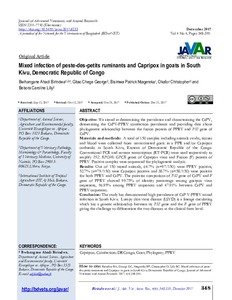| dc.contributor.author | Birindwa, B.A. |
| dc.contributor.author | Gitao, C.G. |
| dc.contributor.author | Bisimwa, P.N. |
| dc.contributor.author | Okafor, C. |
| dc.contributor.author | Bebora, C.L. |
| dc.date.accessioned | 2019-12-04T11:14:14Z |
| dc.date.available | 2019-12-04T11:14:14Z |
| dc.date.issued | 2017-12 |
| dc.identifier.citation | Birindwa, B.A., Gitao, C.G., Bisimwa, P.N., Okafor, C. & Bebora, C.L. (2017). Mixed infection of peste-des-petits ruminants and Capripox in goats in South Kivu, Democratic Republic of Congo. Journal of Advanced Veterinary and Animal Research, 4(4), 348-355. |
| dc.identifier.issn | 2311-7710 |
| dc.identifier.uri | https://hdl.handle.net/20.500.12478/2700 |
| dc.description | Open Access Journal; Published online: 21 Dec 2017 |
| dc.description.abstract | Objective:
We aimed at determining the prevalence and characterizing the CaPV, determining the CaPV-PPRV coinfection prevalence and providing data about phylogenetic relationship between the fusion protein of PPRV and P32 gene of CaPV.
Materials and methods: A total of 150 samples including animals swabs, tissues and blood were collected from unvaccinated goats in a PPR and/or Capripox outbreaks in South Kivu, Eastern of Democratic Republic of the Congo. Conventional PCR and reverse transcriptase (RT-PCR) were used respectively to amplify P32, RPO30, GPCR genes of Capripox virus and Fusion (F) protein of PPRV. Positive samples were sequenced for phylogenetic analysis.
Results: Out of 150 tested animals, 64.7% (n=97/150) were PPRV positive, 52.7% (n=79/150) were Capripox positive and 38.7% (n=58/150) were positive for both PPRV and CaPV. The pairwise comparison of P32gene of CaPV and F gene of PPRV showed 99.75% of identity percentage among goatpox virus sequences, 96.95% among PPRV sequences and 47.91% between CaPV and PPRV sequences.
Conclusion: The study has demonstrated high prevalence of CaP V-PPRV mixed infection in South Kivu. Lumpy skinvirus disease (LSVD) is a lineage circulating which has a genetic relationship between its P32gene and the Fgene of PPRV giving the challenge to differentiate the two diseases at the clinical farm level. |
| dc.format.extent | 348-355 |
| dc.language.iso | en |
| dc.subject | Capripox |
| dc.subject | Capripoxvirus |
| dc.subject | Democratic Republic Of The Congo |
| dc.subject | Goat |
| dc.subject | Phylogeny |
| dc.subject | Coinfection |
| dc.title | Mixed infection of peste-des-petits ruminants and Capripox in goats in south Kivu, Democratic Republic of Congo |
| dc.type | Journal Article |
| dc.description.version | Peer Review |
| cg.contributor.crp | Roots, Tubers and Bananas |
| cg.contributor.affiliation | Université Evangélique en Afrique |
| cg.contributor.affiliation | University of Nairobi |
| cg.contributor.affiliation | International Institute of Tropical Agriculture |
| cg.coverage.region | Africa |
| cg.coverage.region | Central Africa |
| cg.coverage.country | Congo, Dr |
| cg.creator.identifier | Chris Okafor: 0000-0003-2162-6101 |
| cg.authorship.types | CGIAR and developing country institute |
| cg.iitasubject | Biodiversity |
| cg.journal | Journal of Advanced Veterinary and Animal Research |
| cg.howpublished | Formally Published |
| cg.accessibilitystatus | Open Access |
| local.dspaceid | 93624 |
| cg.targetaudience | Scientists |
| cg.identifier.doi | http://dx.doi.org/10.5455/javar.2017.d233 |

